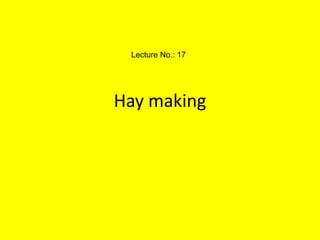
Hay-making.ppt
- 1. Hay making Lecture No.: 17
- 2. Hay • Hay making is an art in which the fodder is kept for future use in lean period. Since it contains large quantity of moisture it is to be dried properly to increase its keeping quality without reducing its nutritive value. The forage growers follow a different type of processes for making the green fodder as hay
- 3. • Hay is the main source of feed for cattle during lean months. The forage crop is cut before it is fully ripe and dried for storage as hay. Hay is more nutritious and palatable than straw. It is leafy pliable green and free from mould, weeds and dust and has a pleasant characteristic smell and aroma
- 4. Properties of Good Hay 1. The fodder cut at the proper stage will have the maximum nutrients, therefore will make better hay. Any delay in cutting the fodder for hay making results in woody and lignified stems which will have deteriorated nutritive value. 2. Good hay will be having a major proportion of the leaves preserved. The leaves are richer in nutrients and if there is any shattering of leaves during hay making it reduces the quality of hay. 3. Green colour of hay is an indication of its quality. We should preserve the green colour by minimizing the bleaching, leaching arid fermentation losses. 4. It should be made out of thin stemmed crops so that it is soft and palatable. 5. The crop used for hay making should be free from weeds and poisonous plants to get good hay. 6. The hay should have 20-23% moisture when stored. 7. Good hay should be free from dust and molds. 8. It should have a pleasant aroma which adds to its palatability.
- 5. Types of Hay • Legume hay • Legume hay are of special value to dairy cattle. The hay contains higher digestible nutrients and the digestible protein is of superior quality. They are rich sources of carotene, vitamin A, E and K. It is considerably rich in calcium and is highly palatable. Legume hay are made out of leguminous plants like lucerne, berseem, cowpea, groundnut, and kudzu. The digestible crude protein content range from 6.7-14% in these types of hay. Legume hay are usually fed to young l calves in calf starter rations. • Some of the perennial fodder legumes like Centrosema pubescens, Glycine javanica, Atylosia scarabaloides and Dolichos lab lab for feeding to livestock either as such or converting them into hay.
- 6. Types of Hay • Non-legume hay • The out-turn per hectare is more but the hay made is less palatable and nutritious compared to legume hays. The non-leguminous hay contains less proteins, minerals and vitamins. This type of hay may be made from either crops or grasses. • Some of the important grass hay include Ahmednagar hay, Ambala hay, Anjan hay, Arali hay, Aurangabad hay, Bolaram hay, Dalhousie hay, Dub hay and Meerut hay.
- 7. Types of Hay • Grain Crop hay • Grain crop hay are made from oats and barley, harvested at milk stage. It has low protein and mineral content but are rich in carbohydrates. Oat is the only graminaceous forage crop of winter. For hay making in February -March the oat needs to be kept for about 120-144 hours in shade and 96-120 hours in sun to dry. • Total digestible nutrients of oats is 59.8% and the crude protein is 6.1 per cent.
- 8. Types of Hay • Mixed hays • Mixed hay is made from a mixed crop of leguminous and non-leguminous plants. Such a crop is generally cut early as they do not come to the flowering stage simultaneously. The nutritive value of mixed hay will depend on the proportion of leguminous and non- leguminous plants.
- 9. Steps in hay making • 1. Selection of suitable varieties • 2. Proper stage for cutting • The stage of growth of plant is the most important consideration in harvesting the forage crops. When the crop is cut at early stages, the yield is less but the product will be more nutritious. Smaller yields and frequent cuttings increase labour cost. • For lucerne, the first cutting is done at early bloom stage and the second and subsequent cuttings are done when one-tenth to one fourth of the crops are in bloom or when new shoots begin to develop from the crown.
- 10. Steps in hay making • A. Curing • Losses in nutrients due to leaching from rain is the major loss when one tries to make hay during monsoon season. The leaching losses are negligible if the rain falls just after cutting of the crop. Losses increase with the advancement of curing if leaching takes place. • Moisture content • moisture content of 70-80% but this is too much for hay making, so the following moisture content has to be kept for making good hay. • (i) For loose hay -25-28% moisture • (ii) For bundled hay -22-25% moisture • (iii) For chopped hay -19-22% moisture. • two thumb rule methods are followed. • i. The scrape method • ii. The twist method • 5. Storage
- 11. Methods of Hay Making . • Field curing 1. Cutting the crop 2. Swath curing 3. Raking 4. Cocking 5. Bailing and storing
- 12. Methods of Hay Making . • B. Mow curing • C. Dehydration • D. Pelleting
- 13. Hay Making Under Rural Conditions 1. On the ground 2. On frames 3. On small fences 4. On tripods 5. On poles
- 14. • thanks